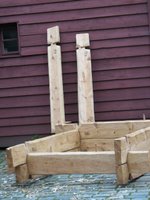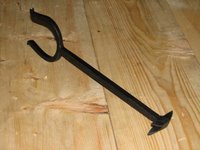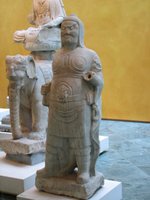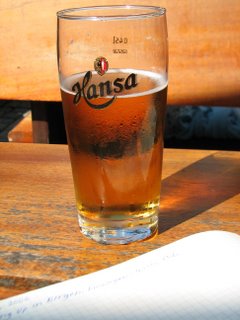Friday, July 07, 2006
Bergen, July 3-4












 Monday morning I was ready to see more stuff. I headed to the old town part of Bergen, the Bryggen.
Monday morning I was ready to see more stuff. I headed to the old town part of Bergen, the Bryggen.This is a city block of old buildings right along the harbor that were originally built in the 12th century. The buildings were the center of the fish trade, which was tightly controlled by the Hanseatic Leauge of German merchants until the 1700s. The buildings of the Bryggen have burnt down several times over the centuries, and have been continuously rebuilt in the same way. The current structures were last built in 1702, and are being restored and preserved currently.
Alf Isak, Silje's good friend, is an architecture student in Bergen who is making the woodworking demonstrations and giving public tours in the Bryggen during the summer, and another one of their friends, Jacob, is one of the woodworkers restoring the buildings. Alf and Jacob taught me all about the old construction methods still being used here today. The restoration work is necessary because some of the pine of the building and foundations is decomposing. The rebuilding is being built almost entirely with the same types of tools and techniques as the original buildings were in 1702.
The buildings are almost entirely made of pine. The construction method is another traditional Norwegian method called "lafting". Lafting is very different than the "grindbygningen" technique I learned about in Voss. Not to simplify it too much, but lafting is more like Lincon Logs where the logs are interlocked at the building corners. The sides are hewn of a whole log with an axe to make one thick plank, a laft. This 5-6 inch thick plank includes the heartwood and the pith of one log, so it is very stable. As Alf will demonstrate, to hew the log, first notches arechopped down the length of the log, then the remaining wood is lopped off. The ends get an edge lap/ bridal joint. The work is almost entirely done with an axe; it can be very quick and accurate for a skilled worker.
There is a great trick for getting a tight fit between the lafts as they are stacked on top of each other lengthwise. After the sides are hewn off the logs, the top and bottom edges of the laft are beveled on both sides with a drawknife so that they have a pointed edge. When one laft is stacked above the last one, they rest point to point. A forked, double pronged scribe called a "me" is used to "medrag" or scribe a double line: one line on the upper laft, one on the lower. The two lines are parallel, so even though the surface will not be a flat plane, the two surfaces will match up if both lafts are trimmed to the scribe lines. I need to get me one of these medrags for all of my fitting a curve to a curve work!
Looking around, I noticed that the natural forms of curved wood were constantly being used here too. In grindbygningen, the curved parts cross brace the upright and the horizontal beams. In lafting, the point where the trunk widens and spreads into the roots is used as a corner block to support the external walkways or gangplanks cantileivered around the buildings. This particular part of the tree is called the knee of the tree, and a lot of tree's knees are being used in Bryggen.
After work, Alf joined me for a pint (.45 liters actually, a norsk pint). I think he deserved it after all of that chopping. It made me thirsty!
------------------------------------------
The Fourth of July was on a Tuesday. Seeing as it was a holiday, I slept in and spent a late morning at a cafe writing postcards. At 11:00 am I was having a coffee, but most of the people on the patio were having their norsk pints already. I guess everyone was having a holiday. I kept waiting for the city to set up bleachers and parade route detours next to the harbor, but that never happened. I visited Alf and Jacob at Bryggen again to see some more chopping. I really admire hard work; I could watch someone work hard all day long. (I can't take credit for that one, but I can't recall to whom I should give the credit.) Actually, I wanted to show them Kåre Herfindal's book which they had not seen yet. We were being wood geeks together.
In the afternoon, I visited the Vestlandke Kunstindustrial Museum. I was hoping to see some great examples of traditional or typical Norwegian wood furniture. There was a collection of period furniture with some contemporary stuff mixed in, but nothing in that exhibit grabbed me. What did catch my attention was the Chinese sculpture exhibit. I really liked the attitude and posture on this one warrior . . . sort of knock'um sock'um.
Well, I had pretty much done everything I wanted to do in Bergen. I had been hearing the Irish pub through my bedroom window for several days, and I decided it would be a good place for me to do some individual celebration of the Fourth. Skål everyone!